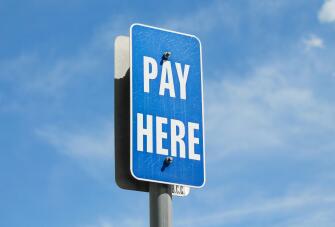What does ACH stand for? Guide To ACH Payments
Remember when we used to send bills and wait for paychecks in the mail? Those days are pretty much over. Nowadays, we shop online, use direct deposits, pay bills, and even file taxes, all through the Internet.
The thing that makes all these digital transactions work is a little something called Automated Clearing House, or ACH for short.
So, in this complete guide, we're giving you the lowdown on all things ACH payments. From what they are and some key facts about them, to how ACH payments work and their advantages and disadvantages.
Let's get started!
What does ACH mean?
Automated Clearing House (ACH), is a US financial network used for electronic payments and money transfers. Basically, ACH payments move money between bank accounts without using paper checks, credit cards, wire transfers, or cash.
ACH payments are becoming more common every year. In 2022, over 30 billion electronic payments went through the ACH network, totalling $76.7 trillion—that's more than a 5% increase from 2021.
You're probably using ACH payments already without even realizing it. If you pay your bills online or get your paycheck through a direct deposit, that's ACH in action.
As a business owner, ACH payments are a great alternative to paper checks and credit cards. They're faster and more reliable than checks and help simplify accounting. Plus, ACH transfers usually cost less to process than credit card payments or wire transfers.
Key facts about Automated Clearing House
Here's a quick fact sheet about Automated Clearing House:
- Applicable accounts: Checking and savings accounts only
- Areas of operation: United States and Puerto Rico
- Governing body: NACHA (The Electronic Payments Association)
- Typical processing times: Funds are available within about three to five business days
What does ACH mean in banking?
In banking, ACH payments (or ACH transfers) move money directly from one bank account to another. They're handled by an ACH operator on the ACH network, managed by Nacha.
Banks use ACH transfers to move money between accounts, pay bills, handle business payments, process online shopping payments, and even for peer-to-peer transfers. To make an ACH payment, banks send or accept a payment instruction, which then gets processed through the ACH network.
Types and examples of ACH payments
Now, you've got 2 types of ACH payments out there. Here's an explanation of both:
What is ACH debit?
ACH debit transactions usually involve money pulled from your bank account. For example, when you set up automatic bill payments for your internet service, the internet provider pulls the payment directly from your account each month.
What is ACH credit?
Then you've got ACH credit transactions. These let you "push" money to your own or others' banks. Say you're sending money to a friend using your bank's online transfer service. In this case, you'd be pushing money from your account to your friend's account using an ACH credit transaction.
How does ACH work?
Aside from the Automated Clearing House (ACH) network, which links all the banks in the U.S., there are three key players in ACH payments:
- Originating Depository Financial Institution (ODFI): This is the bank that starts the transaction.
- Receiving Depository Financial Institution (RDFI): This is the bank that receives the ACH request.
- National Automated Clearing House Association (NACHA): This organization oversees and regulates the ACH network.
Let's use your automated monthly phone bill payments as an example of how these players work together. When you sign up for autopay with your phone company, you give them your checking account details (routing and account number) and authorize recurring payments. These payments will continue as long as you have sufficient credit in your account.
How to make an ACH payment?
Making an ACH payment is simple. Here's how you do it:
- First, you'll need the recipient's bank account details: their account number and routing number.
- Log into your bank's online portal or app and choose the option for making a transfer or payment. Select ACH transfer if available.
- Enter the recipient's details, the amount you want to send, and any necessary payment info. Confirm the details and submit the payment.
- Your bank will process the transfer through the ACH network, usually taking one to three business days. Make sure you have enough funds in your account to avoid any fees or bounced payments.
ACH processing time
A standard ACH payment usually takes one to three business days. But the timing can change based on:
- When the transaction was started
- If the originator chose a same-day transfer
- If there are issues like incorrect info or insufficient funds
ACH transactions are processed up to six times a day. The network also supports same-day processing, which is growing fast.
Unlike wire transfers, ACH transactions can be automatically returned if there are issues. This system operates on a "no news is good news" basis, meaning if there's no return code, the transaction went through. Consumers have up to 60 days to report an unauthorized ACH debit, but most reports come in within a day or two of the transaction.
How much is the cost of ACH payments?
ACH transactions are generally cheaper for businesses than credit card payments. The exact cost depends on your provider.
Some ACH processors charge a flat fee (that's usually between $0.25 and $0.75 per ACH transaction). Others might charge a percentage fee (which is typically between 0.5% and 1% per transaction). There can also be a monthly fee for ACH services, which varies by provider.
Payment processing services made simple
Take integrated payments at one fixed rate, with no hidden fees - anywhere, any time.
What are the benefits of ACH payment processing?
There are so many reasons why ACH payments are becoming an attractive option for businesses. These benefits include:
Lower processing fees
ACH payments usually come with the lowest processing fees around. If you go with a provider that charges a flat rate, you'll end up spending a lot less on processing fees for ACH payments compared to credit cards. It's a great way to save money for your business.
Fewer declined transactions due to expiration
Unlike credit and debit cards, checking accounts don't expire. This means you'll face far fewer declines when processing ACH payments. It's one less hassle to worry about.
Greater flexibility for your business and your customers
Offering different payment options improves the customer experience. With ACH payments, customers don't have to dig out their checkbooks each month. They can simply "set it and forget it" by signing up for recurring billing.
Plus it's simpler for you. It means that you don't need to use paper invoices anymore, and you can also avoid paper checks, and time-consuming trips to the bank.
What are the disadvantages of ACH payments?
Now onto the downsides of an ACH transfer:
Processing time
ACH payments can take a good few days to process, normally around 3 to 5 business days. During this time, the funds are transferred between bank accounts, which involves several steps to ensure security and accuracy.
ACH caps
There can be daily and monthly caps on how much money you can move. The Same Day ACH per transfer limit is set at a maximum amount of $100,000. Now, this has gone up a lot since 2021. Before it was capped at $25,000. According to Nacha, since increasing the cap, 97% of all ACH B2B payments are now eligible for same day ACH payments, compared to 91% under the previous per payment limit.
Limited time frame
After a certain time of day, called the cutoff time, any transfer you initiate might not go through until the next business day. Let's say it's Friday afternoon, and you try to send some money. If it's past the cutoff time, you might have to wait until Monday for it to process ACH payments, especially if the weekend's coming up or there's a holiday. See, banks and financial institutions tend to have these deadlines for getting things done, and if you miss the boat, your transfer gets pushed to the next business day.
Only accessible for US businesses
Chances are, your bank doesn't let you do ACH transfers to or from international bank accounts. They keep it local within the good ol' U.S. of A. So if you're trying to send money abroad or get some from overseas, you might need to explore other options. It's just how things roll in the world of banking.
How to accept ACH payments in your business
Small businesses aren't set up by NACHA to handle ACH transactions directly. However, you can work with a bank or payment processor that's equipped to manage ACH payments.
Epos Now uses ACH to swiftly deposit the funds from your Epos transactions into your linked bank account. These transfers are bundled and sent out on a regular schedule (we also rely on ACH payment processing and deposit funds into sellers' accounts via Epos Now Capital.)
With Epos Now, ACH deposits are usually available by the next business day. If your business's close of day is set before 5 p.m. PT (the default), your funds will arrive in your bank account by the following business day.
TIP: Check out our blog on how to integrate accounts with your POS system for more!
FAQ about ACH payments
- Are there any penalty fees with ACH payments?
-
Yes, there can be fees. If you don't have enough money in your account, you might get hit with an overdraft or NSF (Non-Sufficient Funds) fee. Also, if you enter the wrong account details, the payment could bounce, leading to a fee. Check with your bank to know their exact charges.
- What's the difference between ACH, EFT, and wire payments?
-
ACH and EFT are both electronic payments, with ACH being a type of EFT. ACH payments are processed in batches and take a few days. Wire transfers are faster, done individually, and usually cost more. ACH is cheaper but slower; wire transfers are quick but pricier.
- Do banks charge for ACH transfers?
-
It depends. Some banks offer free ACH transfers for personal accounts, especially for things like direct deposits or bill payments. However, business accounts might have fees per transaction. Always check with your bank to see what they charge.
- Are ACH payments safe?
-
They are, indeed. ACH payments use secure networks and encryption to protect your info. They're also regulated by NACHA, which has super strict rules for security. Just keep an eye on your accounts to catch any unauthorized transactions quickly.
TIP: Epos Now Payments is used by thousands of retail and hospitality businesses across the globe. With over 10 years of experience in cloud-based POS software and integrated payment solutions, we're one of the world leading payment processors. All Epos Now Payment terminals are PCI compliant by default through our innovative encryption technology.
- Can ACH payments be traced?
-
Yes, they can! Both banks involved keep records of the transaction. If you need to track a payment, your bank can give you a trace number to see where it is in the process. This helps make sure the money gets to the right place.




